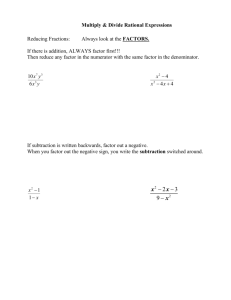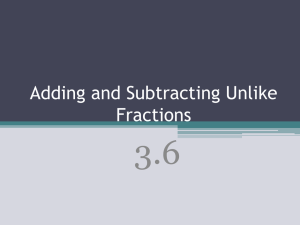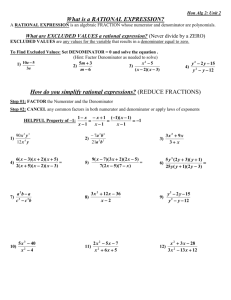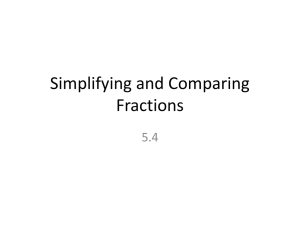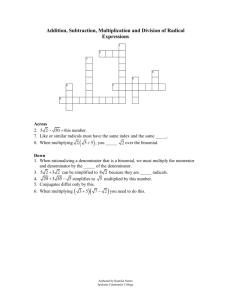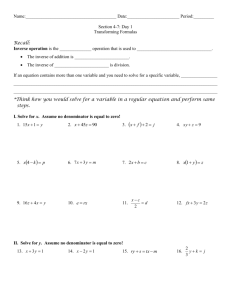8.4-8.7 Study Guide
advertisement
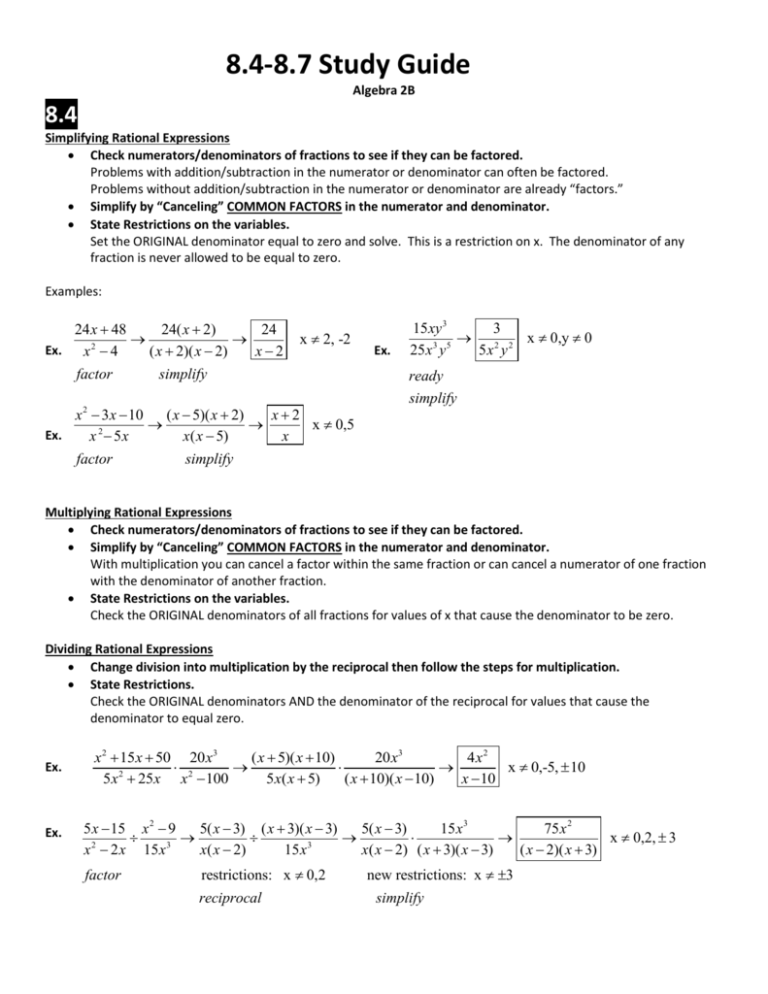
8.4-8.7 Study Guide Algebra 2B 8.4 Simplifying Rational Expressions Check numerators/denominators of fractions to see if they can be factored. Problems with addition/subtraction in the numerator or denominator can often be factored. Problems without addition/subtraction in the numerator or denominator are already “factors.” Simplify by “Canceling” COMMON FACTORS in the numerator and denominator. State Restrictions on the variables. Set the ORIGINAL denominator equal to zero and solve. This is a restriction on x. The denominator of any fraction is never allowed to be equal to zero. Examples: 24 x 48 24( x 2) 24 2 Ex. x 4 ( x 2)( x 2) x2 factor simplify x 2, -2 x 2 3x 10 ( x 5)( x 2) x2 x 0,5 2 Ex. x 5x x( x 5) x factor simplify Ex. 15 xy 3 3 x 0,y 0 3 5 25 x y 5x2 y 2 ready simplify Multiplying Rational Expressions Check numerators/denominators of fractions to see if they can be factored. Simplify by “Canceling” COMMON FACTORS in the numerator and denominator. With multiplication you can cancel a factor within the same fraction or can cancel a numerator of one fraction with the denominator of another fraction. State Restrictions on the variables. Check the ORIGINAL denominators of all fractions for values of x that cause the denominator to be zero. Dividing Rational Expressions Change division into multiplication by the reciprocal then follow the steps for multiplication. State Restrictions. Check the ORIGINAL denominators AND the denominator of the reciprocal for values that cause the denominator to equal zero. Ex. Ex. x 2 15 x 50 20 x3 ( x 5)( x 10) 20 x3 4 x2 x 0,-5, 10 5 x 2 25 x x 2 100 5 x( x 5) ( x 10)( x 10) x 10 5 x 15 x 2 9 5( x 3) ( x 3)( x 3) 5( x 3) 15 x 3 75 x 2 x 0,2, 3 x 2 2 x 15 x 3 x( x 2) 15 x 3 x( x 2) ( x 3)( x 3) ( x 2)( x 3) factor restrictions: x 0,2 reciprocal new restrictions: x 3 simplify 8.5 Adding/Subtracting Rational Expressions Check denominators of fractions to see if they can be factored. Problems with addition/subtraction in the denominator can often be factored. Problems without addition/subtraction in the denominator are already “factors.” Multiply numerator and denominator of each fraction by a value that will create COMMON DENOMINATORS. Simplify your numerators. Write the combined numerators over the COMMON DENOMINATOR. Check to see if your new numerator will factor. Simplify if possible. State the restrictions on the variable. 3 7 2 y 2 3 5x 7 6 y2 35 x 6 y 2 35 x x 0,y 0 Ex. 15 x 2 y 6 xy 3 2 y 2 15 x 2 y 5 x 6 xy 3 30 x 2 y 3 30 x 2 y 3 30 x 2 y 3 create common denom. Ex. x 5 3 4 3 4 x2 3 4 2 x 25 x 7 x 10 ( x 5)( x 5) ( x 5)( x 2) x 2 ( x 5)( x 5) x 5 ( x 5)( x 2) factor , change " " to " " create common denom. 2 3 x 6 4 x 20 x 26 x 5,-5,-2 ( x 5)( x 5)( x 2) ( x 5)( x 5)( x 2) 8.6 Solving Equations with Rational Expressions Check denominators of fractions to see if they can be factored. Problems with addition/subtraction in the denominator can often be factored. Problems without addition/subtraction in the denominator are already “factors.” Determine the Least Common Denominator (LCD) for all fractions in the problem. Multiply all terms in the equation by the LCD. Simplify to eliminate fractions. Solve. Check the restrictions on the variable for possible extraneous roots. Ex. Ex. 4 3 1 2 x2 x 4 x2 4 3 1 x 2 ( x 2)( x 2) x 2 5 3 x2 x5 5 3 ( x 2)( x 5) ( x 2)( x 5) x 2 x5 ( x 5)(5) ( x 2)(3) 5 x 25 3 x 6 3 4 1 ( x 2)( x 2) ( x 2)( x 2) ( x 2)( x 2) x2 x2 ( x 2)( x 2) ( x 2)(4) (3) x 2 2 x 31 x 15.5 4x 8 3 x 2 4 x 11 x 2 3 x 13 13 x x 4.3 3
